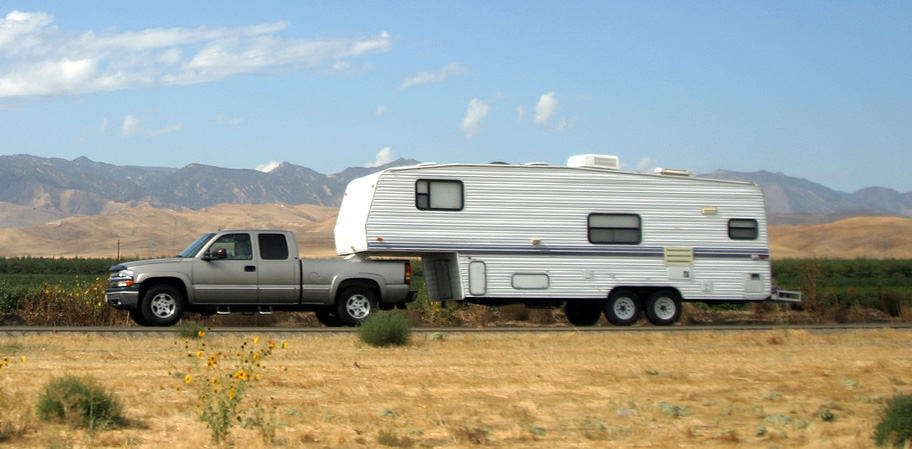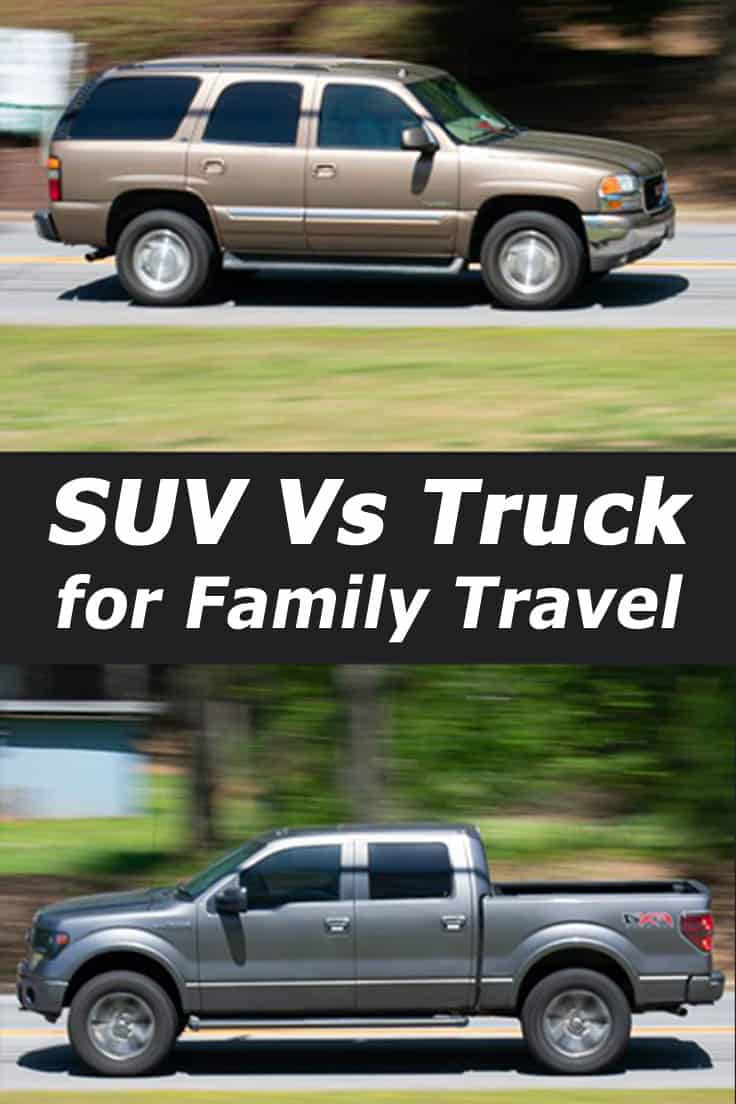For your family travel needs, which vehicle should you buy - or maybe even rent? A new pickup truck or an SUV?
In all likelihood, if you're not towing a travel trailer or a 5th wheel, a full-size SUV will probably be the better choice for you. If, on the other hand, you're going to tow a 5th wheel, you'll definitely need a pickup truck for that gooseneck hitch. Towing a travel trailer? A smaller one could be towed by either vehicle, but if you're going for a larger, heavy or long, travel trailer, a pickup truck is your best bet.
How exactly did we come to these conclusions? Read on to see what the pros and cons are for each option and you'll see. It's important that you read through this post in its entirety because even the statement above comes with its own caveats, so please, if you're still not sure - read on.
The Rise of the SUVs and Pickup Trucks for Family Travel
Once the vehicle of choice for family vacations, the family station wagon has been replaced by the SUV and the pickup truck for a number of reasons. Trucks and SUVs have more room, can go places that a car or station wagon could not even dream of and can tow a boat or trailer weighing up to 7,000 pounds or more.
SUVs and trucks have evolved over the years and feature all the creature comforts of a car. They range in price from under $20K to well over $100K for top end luxury vehicles from Cadillac or Lincoln. Hey, even Porsche and Jaguar have entered this highly lucrative market.
Consider sales stats:
The popularity of these vehicles is in the numbers. In the year 2017 alone a total of 6.7 million vehicles were sold in the US. Of that number 4.7 million were SUVs and trucks.
Clearly these are popular choices in spite of higher fuel costs. A typical truck or SUV averages 12 to 17 miles per gallon and this goes down if you plan on towing a boat or trailer. Offsetting the higher operating cost is the higher resale value, with nine of the top ten vehicles with the highest resale value being SUVs and trucks.
Space and utility are a big factor with some SUVs having seating for up to nine, and extended cab pickups that can seat up to six plus 3000 plus payloads and up to 13,000 pound towing capability. Large SUVs can tow up to 8,000 pounds, which can easily handle a camper style trailer or a boat.
SUVs and Trucks - Size Matters
Both SUVs and pickup trucks have size categories and they matter. Let's take a quick look at the specs that affect overall size of these vehicles.
With pickup trucks, we're talking mid-size trucks vs. full-size cars as the initial categorization.
Mid-size trucks include the following -
Full-Size trucks include the following -
Full-size trucks have sub-categories which traditionally address payload capabilities. Light-duty trucks include half-ton m models like the F-150, the Silverado 1500, Ram 1500 etc. Heavy-duty trucks include the larger models such as the F-250, F-350 and F-450 in Ford's collection, and its counterparts in Chevrolet, Ram, and other companies.
The difference between mid-size trucks and full-size trucks affects the passengers area, so this is a factor in deciding on a truck's suitability for family travel.
For example, compare a Toyota Tacoma with a full-size Toyota Tundra, in terms of passenger space. Both with a standard double cab (Toyota's mid-level cab with two rows of seats). The Tacoma can have 4-5 passengers (depending on the exact model) but backseat passengers will get only 32.6 inches of legroom. Now, the full-size Tundra offers the passengers in a double cab 34.7" of legroom. And two inches of legroom can go a long way when you're on a long family trip.
We'll talk some more about types of cabins later on, but for now, we just wanted to show you the difference between a mid-size and a full-size pickup truck.
Now, SUVs also come in several categories. Ignoring the compact crossovers, we still have a choice between midsize and full-size SUVs. Midsize SUV's have 5-7 seats and they include -
- Ford Edge & Ford Explorer
- Toyota Highlander
- Chevrolet Traverse
- Nissan Pathfinder
- Jeep Grand Cherokee
Full-size SUVs include -
- Ford Expedition
- Chevrolet Tahoe & Suburban
- GMC Yukon
- Nissan Armada
- Toyota Sequoia
Just like with the trucks, size categories matter. Even though a Nissan Pathfinder can carry 7 passengers, it's not nearly as spacious as a Nissan Armada. In the Pathfinder and its equivalent vehicles, the third row of seats offers only minimal legroom, suitable only to children.
So, for the rest of this post, we're going to talk about Full-Size SUVs and compare them to Full-Size trucks.
So, which is the Better Choice for the Family Vacation?
We can agree that:
Nothing beats the utility of a truck or hauling and in most cases off roading.
The question remains as to which is the better choice for family travel? Who cares about hauling and off-roading?
Let's talk pros and cons
To start lets begin with the features and advantages of each type of vehicle. We'll look at four aspects -
- Interior Space
- Cargo Space
- The quality of your ride
- Towing
1. Interior Space
Full-size SUVs are often pickup trucks in disguise. A Chevy Suburban uses the same chassis as a Chevy Silverado. The difference? The bed has been converted into a luxurious passengers area.
That gives SUVs have the additional advantage of being able to seat up to nine passengers.
If you're even considering a truck for road tripping, the type of truck cabs matters a lot. Read our post about types of truck cabs to learn more about each type. In a nutshell, while the names/titles brands give them differ, there are three basic configurations for truck cabs:
- A short/regular cab with one row of seats.
- A double cab with two rows of seats, the second one having more limited space.
- A crew cab (or supercrew) with two rows of full-sized seats.
For family travel, you should opt for a crew cab, just so your backseat passengers can enjoy more legroom and overall space. This does mean you'll end up with a longer vehicle, as you also have the bed of the truck behind you. Also, even the largest of crew cabs only has two rows of seats. In most cases that means five passengers, though you can get a cabin with a bench configuration for the first row, giving you a total of six seats.
So, in total, full-sized SUVs win this category, simply by offering more spacious seating for more passengers.
2. Cargo space
Technically speaking, the truck has the cargo bearing advantage. If your camping plan includes tents, camping gear, cooking appliances and a boat or canoe then a truck may be the choice for you. The additional capacity of an open bed makes this type of transport easier.
With today's extended cab trucks, you can have all this plus room for six. Only it means a super long vehicle that's not so easy to drive.
How about SUVs?
Full-size SUVs have a large cargo area, even with all three rows open. The Ford Expedition XL wins the cargo space contest, offering 42.6 cubic feet of cargo space even with all three rows of seats in the upward position. Other SUVs don't fall far behind. You can see the numbers of cargo area for each of the most popular full-size SUVs here.
Folding or removable seats can increase the cargo capacity considerably to accommodate luggage, camping gear etc. The addition of a roof rack increases load capacity even more, and enclosed rooftop carriers keep belongings safe from the elements while increasing carrying capacity even more.
So, overall, if you have outdoors gear that you prefer to keep out of your passengers area, a pickup truck is perfect for that. Otherwise, a truck with a short bed and two rows of seats, offers about the same cargo volume as a full-sized SUV with its third row folded.
3. Quality of ride
Pickup trucks used to be considered "rough rides". That's not longer the case with the newer models though. Today's pickups are gentle giants. Luxury models generate a sweet overall experience.
Also, as mentioned, many SUVs are basically pickups where the bed has been turned into passenger space. The quality of the ride is the same in both - nice and easy.
Today, this class of vehicles has hundreds of offerings from dozens of manufacturers to fit every lifestyle and budget.
4. Towing
Trucks have the clear advantage with high towing rates although you may need to choose a larger truck than a half-ton to get that advantage over a full-size SUV.
Let's compare the numbers for Ford.
Towing capacity for an F-150 is well over 10,000 lbs.
Towing capacity for a Ford expedition is just 9,300.
And in both cases, you should keep your trailer at about 30% under that number, which makes the Expedition a good fit for towing smaller travel trailers and not much more. Just keep an eye out on the vehicle's overall weight ratings to make sure the weight of the hitch - and the cargo in the SUV or truck - don't take you over the limit even with a smaller camper.
Of course, there's always 5th wheels. If you're even considering family travel with a 5th wheel as your towable, then any SUV is out of the question. As explained my my post about types of RV's, a 5th wheel is a trailer that hitches on the top of a truck with a gooseneck connection.

You just can't hitch a 5th wheel to an SUV. It must have the support of the bed of the truck to hold it up.
And how about image?
Finally, this may or may not be a consideration for you, but we wanted to include it all the same.
What will the neighbors think?
SUVs are often seen as a more friendly type of vehicle in suburban settings, which may be a factor in your neighborhood. They sport a different type of versatility as the large ones can carry more passengers than a truck. They also look a bit more neighbor-friendly because over the years, the styling of these large movers and shakers has become quite attractive, with styling that rival the luxury cars by the same makers.
Pickup trucks - while fast gaining in popularity as family vehicles - are still primarily work vehicles. They may stand out in some areas, making neighbors wondering if you've got a contractor over to renovate the kitchen.
Having said that, half pickup trucks are quickly gaining in popularity. Get this, according to Kelley Blue Book, the #1 selling vehicle in the USA in 2019 so far is the Ford F-series. In second place? The Ram. And in third? The Chevy Silverado! Clearly, pickup trucks are no longer just the work tools of contractors. They have become a legitimate choice for families.
How about you? Which would you prefer and why?
Leave us a comment letting us know.
If you enjoyed following this post and want to pin it for future reference or to share with your followers, that would be awesome. Here's a pin for you to -

The photos used here are by a friend who's a very talented photographer. See her Facebook page here for more awesome photos.
Looking for more SUV related topics? Check out below-
What’s the Best SUV for Towing a Travel Trailer? (Inc. Six Recommendations)
